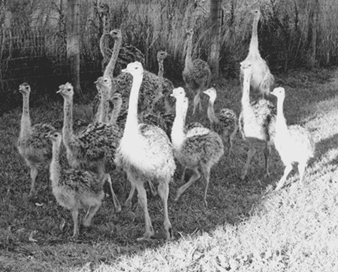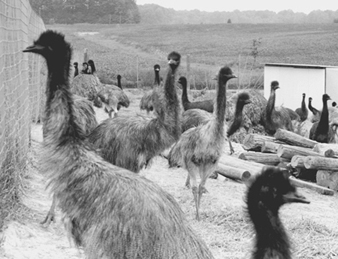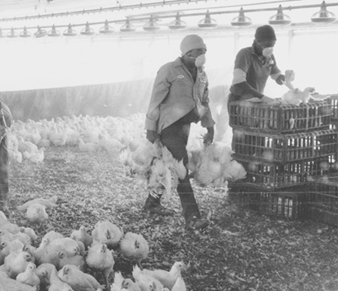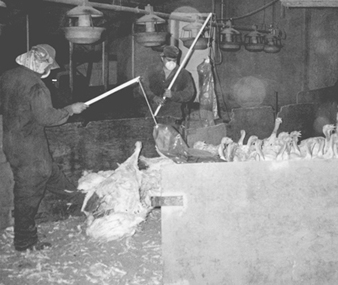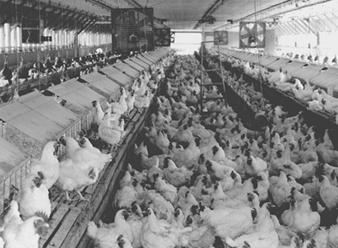Farm production of birds weighing 18 kg or less includes not only domestic birds such as chickens, turkeys, ducks, geese and guineas, but also game birds produced for hunting, such as partridges, quail, grouse and pheasants. While some of these birds are raised outdoors, the majority of commercial poultry and egg production occurs in specially designed confinement houses or barns. Larger birds weighing between 40 and 140 kg, such as cassowaries, rheas, emus and ostriches, are also raised on farms for their meat, eggs, leather, feathers and fat. However, because of their larger size, most of these birds, which are known collectively as ratites, are usually raised outdoors in fenced-in areas containing shelters.
Chickens and turkeys comprise the majority of poultry produced in the world. US farmers annually produce one-third of the world’s chickens—more than the next six leading chicken-producing countries combined (Brazil, China, Japan, France, the United Kingdom and Spain). Similarly, more than half the world’s turkey production occurs in the United States, followed by France, Italy, the United Kingdom and Germany.
While commercial chicken production occurred in the United States as early as 1880, poultry and egg production was not recognized as a large-scale industry until about 1950. In 1900, a chicken weighed slightly less than a kilogram after 16 weeks. Before the emergence of poultry production as an industry, chickens purchased for eating were seasonal, being most abundant in early summer. Improvements in breeding, feed-to-weight conversion, processing and marketing practices, housing and disease control contributed to the poultry industry’s growth. The availability of artificial vitamin D also made a major contribution. All these improvements resulted in year-round poultry production, shorter production periods per flock and an increase in the number of birds housed together from only a few hundred to several thousand. The production of broilers (7-week-old chickens weighing approximately 2 kg) increased dramatically in the United States, from 143 million chickens in 1940, to 631 million in 1950, to 1.8 billion in 1960 (Nesheim, Austic and Card 1979). US farmers produced approximately 7.6 billion broilers in 1996 (USDA 1997).
Egg production has also seen dramatic growth similar to broiler production. At the beginning of the twentieth century, a laying hen annually produced about 30 eggs, mostly in the spring. Today, the annual average per layer is more than 250 eggs.
Ratite farming primarily consists of the ostrich from Africa, the emu and cassowary from Australia and the rhea from South America. (Figure 1 shows a farm flock of ostriches, and figure 2 shows a farm flock of emus.) Ratite farming first started in South Africa in the late 1800s in response to a fashion demand for the wing and tail feathers of ostriches. While ostrich plumes no longer decorate hats and clothing, commercial production still occurs not only in South Africa, but also in other African countries such as Namibia, Zimbabwe and Kenya. Ratite farming also occurs in Australia, Germany, Great Britain, Italy, China and the United States. The meat of these birds is gaining popularity because, while it is a red meat with a beefy taste and texture, it has total and saturated fat levels much lower than beef.
Figure 1. Part of a commercial flock of 3- to 6-week old ostriches
Roger Holbrook, Postime Ostrich, Guilford, Indiana
When processed at about 12 months of age, each bird will weigh approximately 100 kg, of which 35 kg is boneless meat. An adult ostrich can weigh as much as 140 kg.
Figure 2. Commercial flock of 12-month old emus
Volz Emu Farm, Batesville, Indiana
When processed at about 14 months of age, each bird will weigh between 50 and 65 kilograms, of which approximately 15 kilograms is meat and 15 kilograms is fat for oil and lotions.
Poultry Confinement Housing
A typical poultry confinement house in the United States is a long (60 to 150 m), narrow (9 to 15 m) single-storey barn with a dirt floor covered with litter (a layer of wood shavings, sphagnum peat or sawdust). Both ends of a confinement house have large doors, and both sides have half-side curtains running the length of the structure. Watering systems (called drinkers) and automatic feeding systems are located close to the floor and run the entire length of a house. Large, 1.2-m diameter propeller fans are also present in a poultry house to keep the birds comfortable. A poultry farmer’s daily tasks include maintaining acceptable environmental conditions for the birds, ensuring the continuous flow of feed and water and collecting and disposing of dead birds.
Watering and feeding systems are raised 2.5 to 3 metres above the floor when a flock reaches its processing age to accommodate catchers, workers who collect the birds for transport to a poultry processing plant. Collecting chickens is usually done by hand. Each member of a crew must bend over or stoop to gather several birds at a time and place them into coops, cages or crates. Each worker will repeat this process several hundred times during a work shift (see figure 3). For other types of poultry (e.g., ducks and turkeys), workers herd the birds to a collection area. Turkey catchers wave sticks with red bags tied to them in order to separate several birds at a time from a flock and drive them into a holding pen at the barn’s entrance (see figure 4).
Figure 3. Chicken catchers collecting broilers and placing them in crates for delivery to a poultry processing plant.
Steven W. Lenhart
Figure 4. Turkey catchers separating birds from a flock and driving them into a holding pen.
Steven W. Lenhart
Poultry confinement houses vary from this general description depending primarily on the type of birds being housed. For example, in commercial egg production, adult hens or layers have traditionally been kept in cages arranged in parallel banks. Caged laying-hen systems will be banned in Sweden in 1999 and replaced by loose laying-hen systems. (A loose laying system is shown in figure 5). Another difference between poultry confinement houses is that some do not have litter-covered floors but instead have either slotted or plastic-coated wire floors with manure pits or liquid manure catchment areas under them. In western Europe, poultry confinement houses tend to be smaller than US houses, and they utilize block construction with cement floors for easy litter removal. Western European poultry confinement houses are also decontaminated and floor litter removed after every flock.
Figure 5. A loose laying system
Steven W. Lenhart
Health Risks
The health and safety risks of poultry farmers, their family members (including children) and others who work in poultry confinement houses have increased as the poultry industry has grown. Raising a poultry flock requires a farmer to work 7 days a week. Consequently, unlike most occupations, exposures to contaminants occur over several consecutive days, with the period between flocks (as short as 2 days) being the only time of non-exposure to poultry house contaminants. The air of a poultry house can contain gaseous agents such as ammonia from litter, carbon monoxide from poorly ventilated gas-fired heaters and hydrogen sulphide from liquid manure. Also, particles of organic or agricultural dust are aerosolized from poultry house litter. Poultry house litter contains an assortment of contaminants including bird excreta, feathers and dander; feed dust; insects (beetles and flies), mites and their parts; micro-organisms (viral, bacterial and fungal); bacterial endotoxin; and histamine. The air of a poultry house can be very dusty, and for a first-time or occasional visitor, the smell of manure and the pungent odour of ammonia can at times be overwhelming. However, poultry farmers seemingly develop an adaptive tolerance to the smell and to ammonia’s odour.
Because of their inhalation exposures, unprotected poultry workers are at risk of developing respiratory diseases such as allergic rhinitis, bronchitis, asthma, hypersensitivity pneumonitis or allergic alveolitis and organic dust toxic syndrome. Acute and chronic respiratory symptoms experienced by poultry workers include cough, wheezing, excessive mucus secretion, shortness of breath and chest pain and tightness. Pulmonary function testing of poultry workers has provided evidence suggesting not only the risk for chronic obstructive diseases such as chronic bronchitis and asthma, but also restrictive diseases such as chronic hypersensitivity pneumonitis. Common non-respiratory symptoms among poultry workers include eye irritation, nausea, headache and fever. Of approximately 40 zoonotic diseases of agricultural importance, six (Mycobacterium avium infection, erysipeloid, listeriosis, conjunctival Newcastle infection, psittacosis and dermatophytosis) are of concern to poultry workers, although they occur only rarely. Non-zoonotic infectious diseases of concern include candidiasis, staphylococcosis, salmonellosis, aspergillosis, histoplasmosis and cryptococcosis.
There are also health issues affecting poultry workers that are as yet unstudied or poorly understood. For example, poultry farmers and especially chicken catchers develop a skin condition they refer to as galding. This condition has an appearance of a rash or dermatitis and primarily affects a person’s hands, forearms and inner thighs. The ergonomics of poultry catching are also unstudied. Bending to collect several thousand birds every work shift and carrying eight to fifteen chickens, each weighing from 1.8 to 2.3 kg, is physically demanding, but how this work affects a catcher’s back and upper extremities is unknown.
The extent to which the many psychosocial factors associated with farming have affected the lives of poultry farmers and their families is also unknown, but occupational stress is perceived by many poultry farmers as a problem. Another important but unstudied issue is the extent to which the health of farmers’ children is affected as a consequence of work in poultry houses.
Respiratory Health Protection Measures
The best way to protect any worker from exposure to airborne contaminants is with effective engineering controls that capture potential contaminants at their source before they can become airborne. In most industrial environments, airborne contaminants can be reduced to safe levels at their source by the installation of effective engineering control measures. Wearing respirators is the least desirable method for reducing workers’ exposures to airborne contaminants, and respirator use is recommended only when engineering controls are not feasible, or while they are being installed or repaired. Nevertheless, at present, wearing a respirator is still probably the most feasible method available for reducing poultry workers’ exposures to airborne contaminants. The general ventilation systems in poultry houses are not primarily intended to reduce the exposures of poultry workers. Research is going on to develop appropriate ventilation systems to reduce airborne contamination.
Not all respirators provide the same level of protection, and the type of respirator selected for use in a poultry confinement house can vary depending on the age of the birds being raised, age and condition of the litter, drinker type and position of the side curtains (open or closed). All of these are factors affecting airborne agricultural dust and ammonia concentrations. Airborne dust levels are highest during poultry-catching operations, at times to the point that one cannot see from one end of a poultry house to the other. A full-facepiece respirator with high-efficiency filters is recommended as the minimum protection for poultry workers based on bacterial endotoxin measurements made during chicken catching.
When ammonia levels are high, combination or “piggyback” cartridges are available that filter ammonia and particulates. A more expensive powered air-purifying respirator with a full-facepiece and high-efficiency filters may also be appropriate. These devices have the advantage that filtered air is constantly delivered to the wearer’s facepiece, resulting in less breathing resistance. Hooded, powered air-purifying respirators are also available and can be used by bearded workers. Respirators providing less protection than full-facepiece or powered air-purifying types may be adequate for some work situations. However, downgrading the level of protection, such as to a half-mask disposable respirator, is recommended only after environmental measurements and medical monitoring show that the use of a less protective respirator will reduce exposures to safe levels. Repeated exposures of the eyes to poultry dust increase the risk for eye injury and disease. Respirators with full-facepieces and those with hoods have a benefit of also providing eye protection. Poultry workers who choose to wear half-mask respirators should also wear eyecup goggles.
For any respirator to protect its wearer, it must be used in accordance with a complete respiratory-protection programme. However, while poultry farmers experience inhalation exposures for which respirator usage may be beneficial, most of them are not currently prepared to carry out a respiratory protection programme by themselves. This need may be addressed by the development of regional or local respiratory protection programmes in which poultry farmers can participate.
Manure pits should be considered confined spaces. A pit’s atmosphere should be tested if entry is unavoidable, and a pit should be ventilated if it is oxygen-deficient or contains toxic levels of gases or vapours. Safe entry may also require wearing a respirator. In addition, a standby person may be needed to stay in constant visual or speech contact with workers inside a manure pit.
Safety Risks
Safety risks associated with poultry and egg production include unguarded chains, sprockets, winches, belts and pulleys on fans, feeding equipment and other machinery. Scratches, pecks and even bites by the larger birds are also safety hazards. A male ostrich is especially protective of his nest during mating season, and when he feels threatened, he will attempt to kick any intruder. Long toes with sharp nails add to the danger of an ostrich’s powerful kick.
Electrical hazards created by improperly grounded or non-corrosion-resistant equipment or poorly insulated wires in a poultry house can result in electrocution, non-fatal electrical shock or fire. Poultry dust will burn, and poultry farmers tell anecdotes about accumulated dust exploding within gas-fired heaters when the dust was aerosolized during housekeeping chores. Researchers with the US Bureau of Mines have performed explosiveness testing of agricultural dusts. When aerosolized in a 20-litre test chamber and ignited, dust that was collected from the tops of heater cabinets and from window ledges in chicken houses was determined to have a minimum explosible concentration of 170 g/m3. Sieved samples of poultry house litter could not be ignited. By comparison, grain dust evaluated under the same laboratory conditions had a minimum explosible concentration of 100 g/m3.
Safety Measures
Measures can be taken to reduce safety risks associated with poultry and egg production. For protection from moving parts, all machinery should be guarded, and fans should be screened. For tasks involving hand contact with birds, gloves should be worn. High standards of personal hygiene should be maintained, and any injuries, no matter how minor, caused by machinery or birds should be treated immediately to avoid infection. When approaching a ratite, movement toward the bird should be from the side or behind to avoid being kicked. A lockout system should be used when servicing electrical equipment. Poultry farmers should frequently remove settled dust from surfaces, but they should be aware that, on rare occasions, an explosion can result when high concentrations of accumulated dust are aerosolized within an enclosure and ignited.

